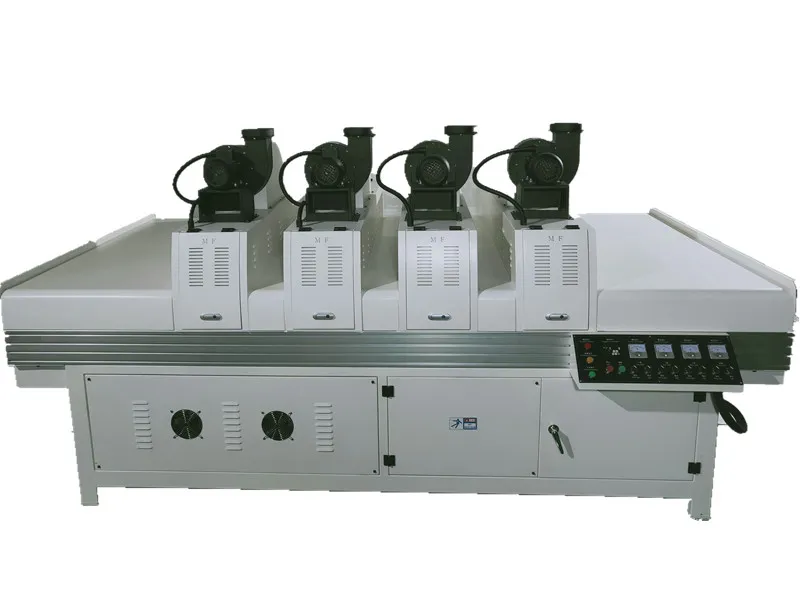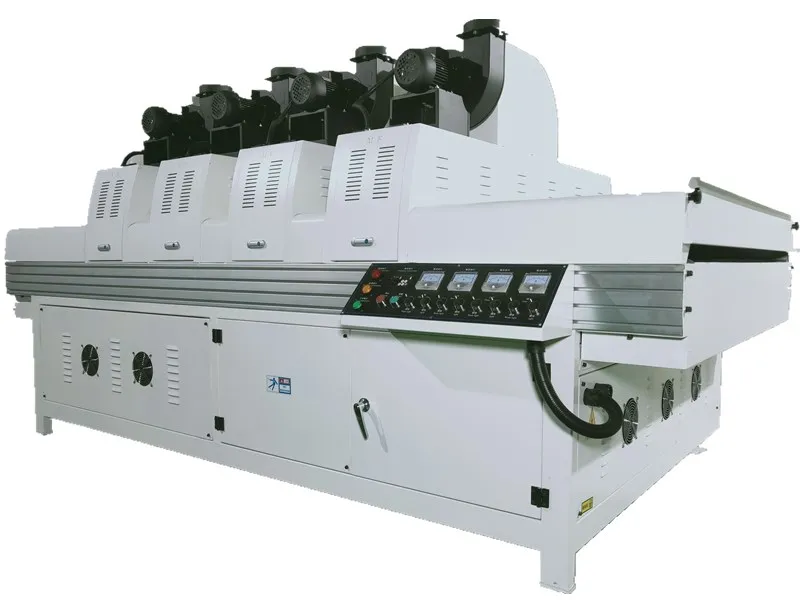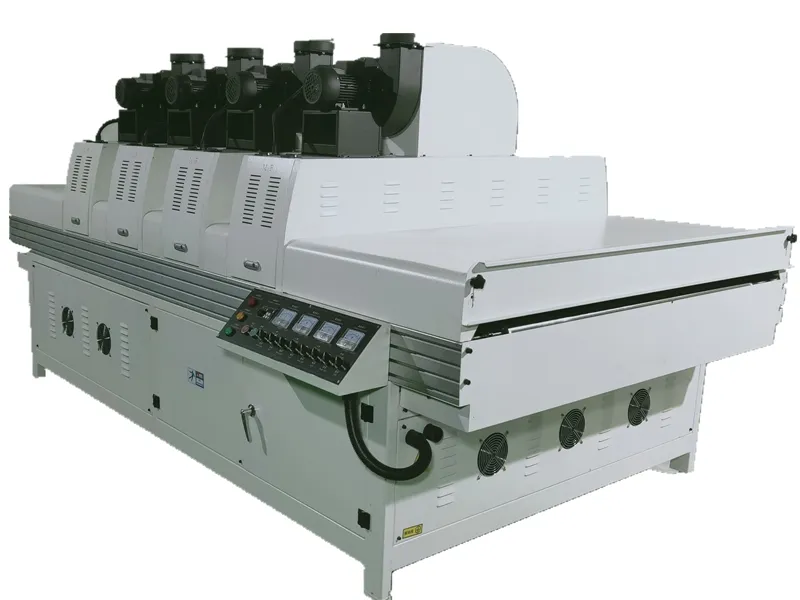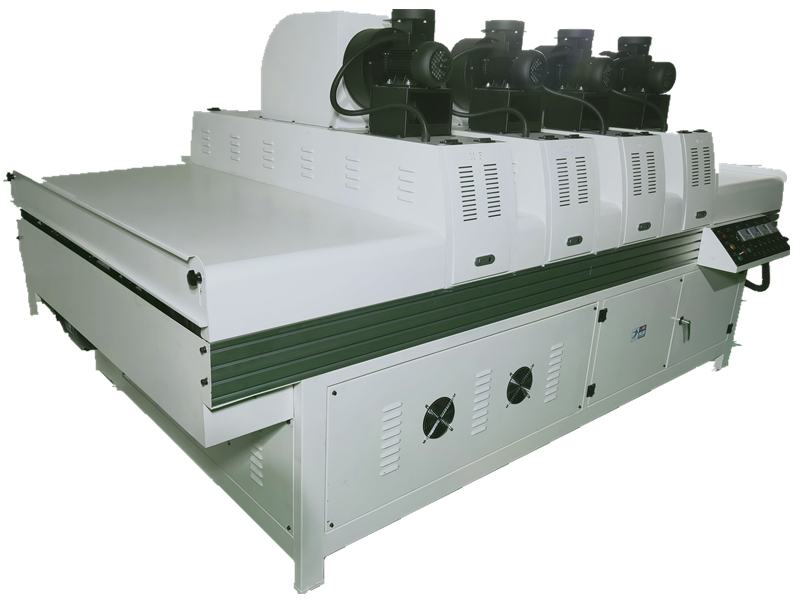In industrial coatings, a UV paint dryer (also known as a UV curing machine or UV light curing machine) is a specialized device that rapidly cures paint into a film using ultraviolet energy. Unlike solvent evaporation or thermal curing, UV drying is essentially a photochemical polymerization reaction: light energy triggers photoinitiators, rapidly crosslinking the monomers/prepolymers in the paint into an insoluble, infusible solid film.
This article, titled "What is the drying process like in a UV paint dryer?", will systematically, professionally, and thoroughly explain the principles of UV curing, equipment components, key parameters, process steps, quality control, common problems, and safety precautions, helping readers gain a comprehensive understanding of the workings of a UV paint dryer.

What is "drying"? How does the term "drying" differ from the traditional meaning in UV paint?
In traditional coatings, "drying" typically refers to solvent evaporation or resin curing via thermal energy. In UV systems, however, "drying" actually involves photopolymerization/crosslinking:
• Photoexcitation: UV photons are absorbed by photoinitiators in the coating;
• Free radical or cation generation: Photoinitiators decompose to produce reactive species such as free radicals or acids (H+);
• Chain growth/crosslinking: Monomers and oligomers undergo chain growth or crosslinking reactions, forming a three-dimensional network structure;
• Instantaneous curing: With sufficient light energy, a film can transform from a wet film to a strong, scrub-resistant solid film in milliseconds to seconds.
Thus, the key task of a UV paint dryer is to deliver UV energy that matches the coating formulation (photoinitiator, monomer/resin, pigments and fillers) under controlled transport speed and exposure conditions, achieving the desired degree of conversion in the coating.
UV paint dryer: What are its components and their functions?
Before understanding the drying process, let's first understand the core components and functions of a typical UV paint dryer:
1. UV Light Source (Lamp)
• Traditional mercury lamps (medium/low-pressure mercury) and modern LED UV lamps are the two mainstream light sources.
• Mercury lamps emit a broad spectrum of UV light (200–400 nm, including UVC, UVB, and UVA). While offering high output, they also generate significant heat and ozone (if the wavelength is <240 nm).
• LED UV lamps emit a narrow spectrum (commonly 365, 385, 395, and 405 nm), offering high energy efficiency, long life, and low or no ozone.
2. Reflector and Collimation System
• Effectively concentrates the emitted UV energy onto the surface being cured, improving utilization.
• Conveyor/Transport System (conveyor belt, turntable, rollers, etc.)
• Controls the speed of the substrate as it passes through the exposure zone, thereby controlling exposure time (exposure time = exposure zone length ÷ conveyor speed).
3. Cooling and Heat Dissipation System
• Both the mercury lamp and the LED generate heat, requiring a water or air cooling system to maintain a stable lamp box temperature and protect the material being cured from overheating.
4. Light Shielding, Guarding, and Safety Interlocks
• Protect personnel from direct UV exposure; opening the door/cover shuts off the light source.
5. Power Supply and Driver Controller
• Mercury lamps require a high-voltage starter/ballast, while LEDs require a constant current or pulsed drive. The controller also regulates output power.
6. Gas Control System (Optional)
• Nitrogen inert atmosphere (N₂ inerting) system to reduce oxygen inhibition (see below).
7. Process Monitoring Equipment
• UV intensity meter (radiometer), temperature sensor, speed/timer, etc. for real-time monitoring, recording, and feedback control.

UV Paint Dryer Machine: What is the Drying Process?
The following describes the operating process of a UV paint dryer in chronological order, breaking it down into several key steps and explaining the technical requirements for each step.
1. Coating Preparation and Application (Before Entering the UV Dryer)
• Uniform coating and controllable thickness are prerequisites for successful curing. Typical UV coating thicknesses range from a few microns to tens of microns, and most UV systems are suitable for thin film curing.
• Pigments and fillers (especially white pigments like titanium dioxide) block UV penetration, reducing deep cure and requiring formulation or process adjustments (reducing opacity, applying in layers, or increasing exposure energy).
2. Feeding and Positioning (Entering the Exposure Zone)
• The substrate is transported steadily, maintaining a constant distance from the lamp and remaining flat to avoid local exposure variations.
• Controlling the conveyor speed to achieve the target exposure time.
3. Initial Exposure (Photoinitiation and Initiation of Reaction)
• UV photons are absorbed by the photoinitiator and decompose to produce active centers (free radicals or acids). This stage typically completes in milliseconds to seconds.
• Light intensity (irradiance, in mW/cm²) and exposure time together determine the total energy dose (dose, in mJ/cm² or J/cm²): Dose = Intensity × Time.
For example: 1000 mW/cm² × 2 s = 2000 mJ/cm² = 2 J/cm². The target dose depends on the coating formulation and film thickness.
4. Chain Growth and Crosslinking (Main Curing Stage)
• Active centers promote rapid polymerization and crosslinking of monomers/oligomers, causing the system viscosity to rise dramatically, and the coating transitions from a liquid to a highly crosslinked solid.
• This step determines properties such as hardness, solvent resistance, and abrasion resistance, and typically occurs within a few hundred milliseconds to several seconds (depending on the dose and formulation).
5. Surface Effects and Oxygen Inhibition (particularly significant in free radical systems)
• Oxygen captures free radicals to form peroxides, which inhibit surface chain growth, resulting in a sticky surface or a thin uncured layer (the so-called "surface inhibition layer").
• Countermeasures: Increase the dose, shorten the exposure distance, or use an inert gas (nitrogen) inertization zone to eliminate surface oxygen inhibition.
6. Deep Cure and Shrinkage Stabilization
• Surface cure is rapid in the early stages of curing, but achieving sufficient conversion to ensure that thicker layers are also cured requires ensuring energy penetration and the photosensitivity of the formulation.
• Crosslinking causes volume shrinkage; the film thickness and formulation should be controlled to avoid stress cracking, deformation, or peeling.
7. Post-Cure/Post-Light Reaction
• Some systems continue to react (post-cure) after irradiation ceases, further increasing the degree of crosslinking; this depends on the residual photoinitiator, the lifetime of active sites, and diffusion behavior.

UV Paint Dryer Machine: Key Process Parameters and Their Impact
To achieve stable and repeatable curing, several parameters in the UV paint dryer must be precisely controlled:
1. Irradiance (mW/cm²)
This determines the intensity of light energy delivered per unit time. Higher intensity requires shorter exposure times. LEDs typically achieve rapid curing with higher instantaneous intensities.
2. Exposure Time / Dose (Dose = Irradiance × Time, mJ/cm² or J/cm²)
The direct driving force for curing. Different coatings have a minimum cure dose and an optimal dose range. Insufficient dose will result in uncured or substandard performance; excessive dose may cause excessive crosslinking, yellowing, or thermal damage.
3. Wavelength Matching
Matching the light source emission spectrum with the photoinitiator absorption spectrum is a prerequisite for efficient light energy conversion. The narrow-spectrum output of LEDs requires the selection of photoinitiators with corresponding wavelengths.
4. Distance and Geometry (Lamp-to-Substrate Distance)
Increasing distance causes the irradiance intensity to decay rapidly in the inverse square of the distance. The appropriate distance must be determined based on the lamp type and reflector design.
5. Film Thickness and Pigments
Thicker films require more energy; pigments (especially opaque white fillers) block UV light, limiting penetration depth.
6. Substrate Thermal Sensitivity
Some substrates (thin plastics, heat-sensitive wood) are heat-sensitive. Excessive lamp power or prolonged high-temperature exposure can cause deformation or discoloration. Therefore, a balance between light power and cooling measures is necessary.
7. Oxygen Content (Whether Nitrogen Inerting is Used)
Nitrogen inerting can significantly reduce oxygen inhibition, improve surface gloss and crosslinking, but it increases equipment complexity and cost.
UV Paint Dryer Machine: Process Differences Under Different Light Sources
1. Mercury Lamp (Medium/Low-Pressure Mercury Lamp)
• Advantages: Broad luminescence spectrum, good compatibility with a variety of photoinitiators, and high instantaneous intensity.
• Disadvantages: High heat generation, ozone generation (including components <240 nm), short lifespan, and the need for thermal management and ozone treatment.
• Suitable for: Conventional thick films or systems requiring deep penetration.
2. LED UV
• Advantages: High energy efficiency, narrow spectrum output, virtually no ozone, long lifespan (tens of thousands of hours), and high intensity immediately after start-up (no preheating required).
• Disadvantages: Narrow spectrum, requiring formulation adjustments (for appropriate initiators); high price, but low total operating costs.
• Applications: Preferred for fine coatings, heat-sensitive substrates, and ozone-sensitive applications.

How to understand and effectively control the drying process of a UV paint dryer?
Drying in a UV paint dryer is a photochemically driven process that couples three key factors: time, intensity, and formulation. Successfully controlling this process requires multiple aspects, including the coating formulation (photoinitiator and resin), light source selection (wavelength and intensity), equipment parameters (distance, speed, cooling), and environmental control (oxygen, temperature and humidity):
1. Prioritize the matching of the light source spectrum and the photoinitiator during model selection;
2. Prioritize film thickness, pigment light-shielding properties, and substrate heat resistance during process design;
3. Strictly control the dose (irradiance × time) during operation and equip the system with monitoring and feedback devices (irradiometer, temperature recorder);
4. In quality control, physical and chemical tests such as surface tack tests and MEK wipes are used to determine the degree of curing completion;
5. In terms of safety and environmental protection, attention should be paid to ozone treatment, UV protection, and waste lamp recycling.
Mastering these key points will ensure that UV paint dryers consistently and reproducibly achieve high-quality, rapid curing results in industrial production.
Why should buyers choose XMF Machinery as their coating equipment supplier?
XMF Machinery, founded in 2006, is a trusted factory and manufacturer of surface coating equipment. Our company designs and produces roller coating machines, spraying systems, UV curing units, embossing equipment, and other solutions for industries such as furniture, flooring, doors, and ceramics.
We supply machines with high quality standards at low prices, and buyers can benefit from direct factory sales, wholesale purchasing, and special promotions. Customers who buy from us also receive reliable technical support and customized coating solutions.
